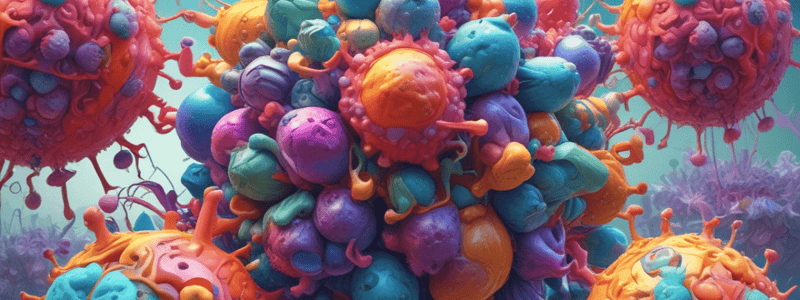Podcast
Questions and Answers
What is the key event that happens during the Penetration stage of the Bacteriophage Lytic Cycle?
What is the key event that happens during the Penetration stage of the Bacteriophage Lytic Cycle?
- Viral components are assembled into virions
- Bacterial virus attaches to the cell wall receptors
- Viral sheath contracts to push viral DNA into the host cell (correct)
- Viral DNA is incorporated into the bacterial host DNA
What is the stage in the Bacteriophage Lytic Cycle where the bacterial host cell is forced to make viral components?
What is the stage in the Bacteriophage Lytic Cycle where the bacterial host cell is forced to make viral components?
- Attachment
- Biosynthesis (correct)
- Penetration
- Maturation
Which stage of the Bacteriophage Lytic Cycle involves the assembly of newly-made, mature viruses?
Which stage of the Bacteriophage Lytic Cycle involves the assembly of newly-made, mature viruses?
- Penetration
- Attachment
- Biosynthesis
- Maturation (correct)
What is the main purpose of viral lysozyme during the Attachment stage of the Bacteriophage Lytic Cycle?
What is the main purpose of viral lysozyme during the Attachment stage of the Bacteriophage Lytic Cycle?
What is a Virion in the context of the Bacteriophage Lytic Cycle?
What is a Virion in the context of the Bacteriophage Lytic Cycle?
During which stage of the Bacteriophage Lytic Cycle is viral DNA present inside the bacterial host cell?
During which stage of the Bacteriophage Lytic Cycle is viral DNA present inside the bacterial host cell?
What happens to the bacterial host cell during the lytic cycle of a bacteriophage?
What happens to the bacterial host cell during the lytic cycle of a bacteriophage?
What happens during the lysogenic cycle of a bacteriophage?
What happens during the lysogenic cycle of a bacteriophage?
What is a consequence of lysogeny in bacterial host cells?
What is a consequence of lysogeny in bacterial host cells?
Which of the following is NOT a stage in the multiplication (lytic cycle) of animal viruses?
Which of the following is NOT a stage in the multiplication (lytic cycle) of animal viruses?
What is the process called when a virus induces the expression of cancer-causing genes in a host cell?
What is the process called when a virus induces the expression of cancer-causing genes in a host cell?
What is the purpose of growing viruses in the laboratory?
What is the purpose of growing viruses in the laboratory?
What is the difference between viral species and viral subspecies/strains?
What is the difference between viral species and viral subspecies/strains?
How are bacteriophages quantified during their growth in bacterial cultures?
How are bacteriophages quantified during their growth in bacterial cultures?
What is the primary method used for identifying viruses in the laboratory?
What is the primary method used for identifying viruses in the laboratory?
What is the difference between the lytic cycle and the lysogenic cycle in bacteriophages?
What is the difference between the lytic cycle and the lysogenic cycle in bacteriophages?
Can animal viruses grow in bacterial cells?
Can animal viruses grow in bacterial cells?
How do enveloped animal viruses enter the host cell?
How do enveloped animal viruses enter the host cell?
What is the process by which the viral capsid is disintegrated to expose the viral genetic material?
What is the process by which the viral capsid is disintegrated to expose the viral genetic material?
Which of the following is a characteristic of non-enveloped animal viruses?
Which of the following is a characteristic of non-enveloped animal viruses?
How can the RNA of an animal virus incorporate into the host cell's DNA?
How can the RNA of an animal virus incorporate into the host cell's DNA?
Which virus family causes warts and cervical/anal cancers?
Which virus family causes warts and cervical/anal cancers?
What is the term used for viruses that can cause cancer?
What is the term used for viruses that can cause cancer?
What is the process by which enveloped animal viruses are released from the host cell?
What is the process by which enveloped animal viruses are released from the host cell?
How can oncoviruses transform normal cells into cancerous cells?
How can oncoviruses transform normal cells into cancerous cells?
How do non-enveloped animal viruses enter the host cell?
How do non-enveloped animal viruses enter the host cell?
What is the process by which non-enveloped animal viruses are released from the host cell?
What is the process by which non-enveloped animal viruses are released from the host cell?
What type of viral infection is characterized by a rapid onset of symptoms and short duration?
What type of viral infection is characterized by a rapid onset of symptoms and short duration?
Which of the following is an example of a transmissible neurological disease caused by prions?
Which of the following is an example of a transmissible neurological disease caused by prions?
Flashcards are hidden until you start studying




